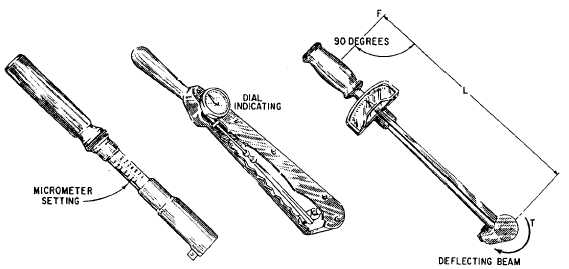Figure 11-26.—Torque wrenches.
use it. When using deflecting-beam or dial-indicating
wrenches, hold the torque at the desired value until the
reading is steady.
Torque wrenches are delicate and expensive tools.
When using them, always follow these precautions:
l
l
l
l
l
l
When you use the micrometer-setting type, do
not move the setting handle below the lowest
torque setting. However, place it at its lowest
setting before you return it to storage.
Do not use the torque wrench to apply greater
amounts of torque than its rated capacity.
Do not use the torque wrench to break loose bolts
that have been previously tightened.
Do not drop the wrench. If a torque wrench is
dropped, its accuracy will be affected.
Do not apply a torque wrench to a nut that has
been tightened. Back off the nut one turn with a
nontorque wrench and retighten it to the correct
torque with the indicating-torque wrench.
Calibration intervals have been established for all
torque tools used in the Navy. When a tool is
calibrated by a qualified calibration activity at a
shipyard, tender, or repair ship, a label showing
the next calibration due date is attached to the
handle. Before you use a torque tool, check this
date to make sure the tool is not overdue for
calibration.
SUMMARY
Only a few of the many types of instruments used
by Navy personnel have been covered in this chapter.
For the operating principle of individual systems, you
should consult the specific equipment technical manuals
and the NSTM, chapter 504.
Just as we monitor automobile instruments (oil
pressure gauge/light, fuel tank level indicator, water
temperature gauge, and so forth) to determine how an
automobile is operating, we use instruments to
determine how the engineering plant is operating. In
addition to the use of visual indicating equipment in an
engineering plant, audible alarms warn operating
personnel of actions required or of unsafe conditions
that are approaching. You may avoid machinery
damage, personnel injury, and expensive and
time-consuming repairs by taking proper operator
action. However, proper operator actions can take place
only when the instruments (temperature indicators,
pressure gauges, and so forth) are properly calibrated
and properly interpreted by operating personnel.
11-15

